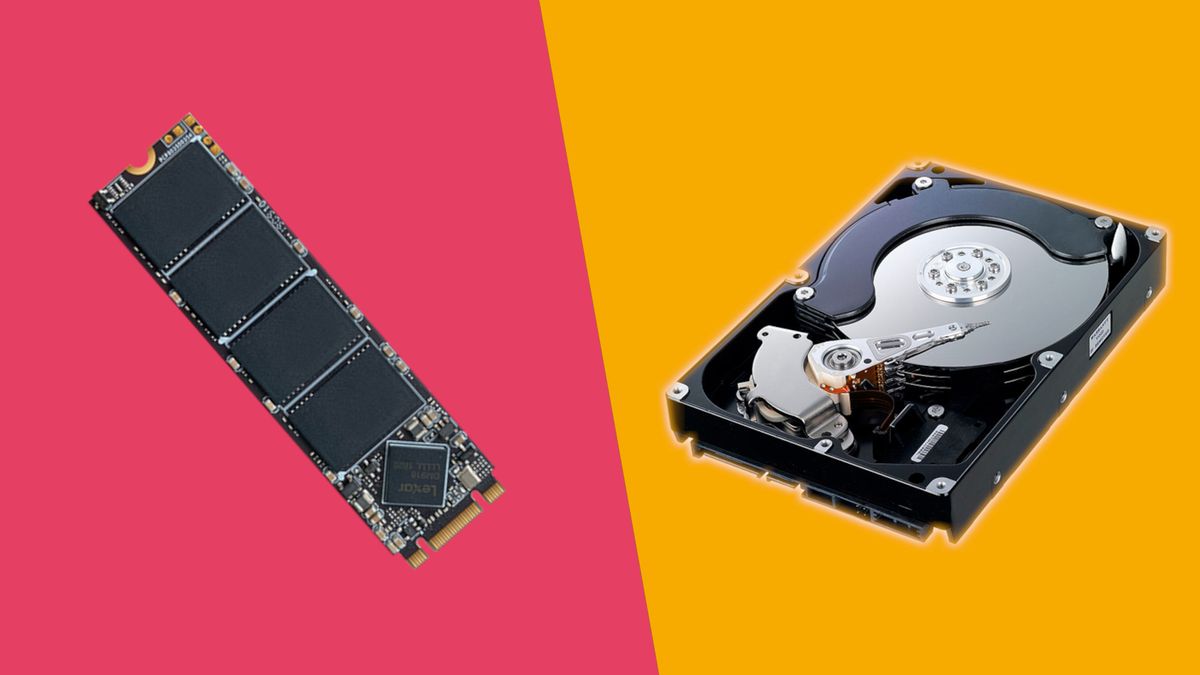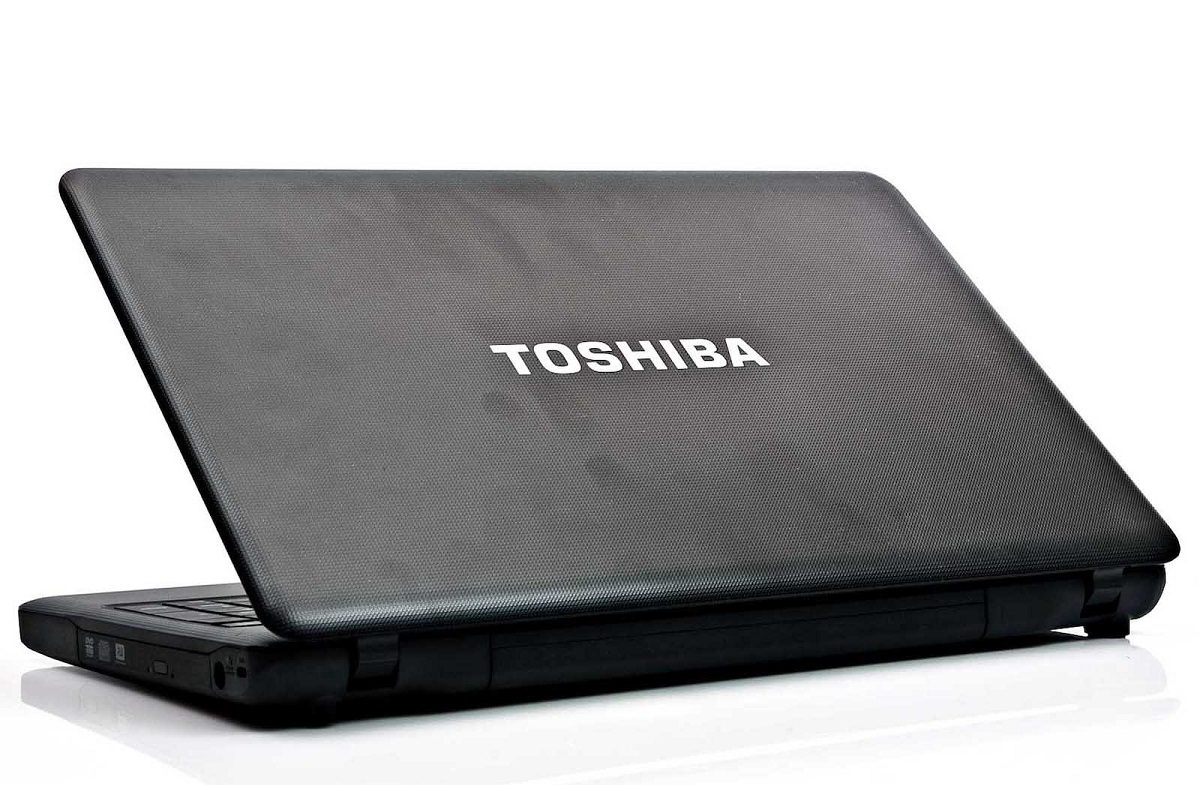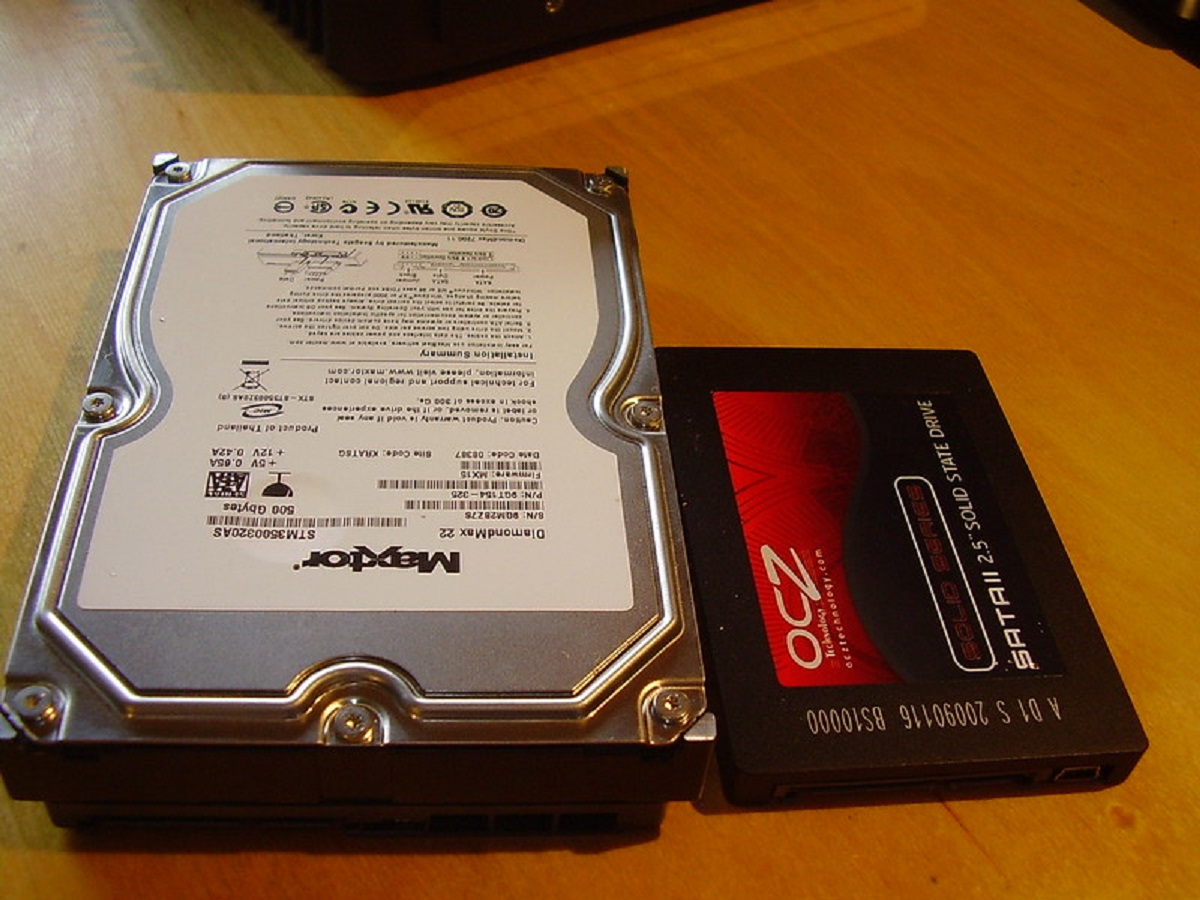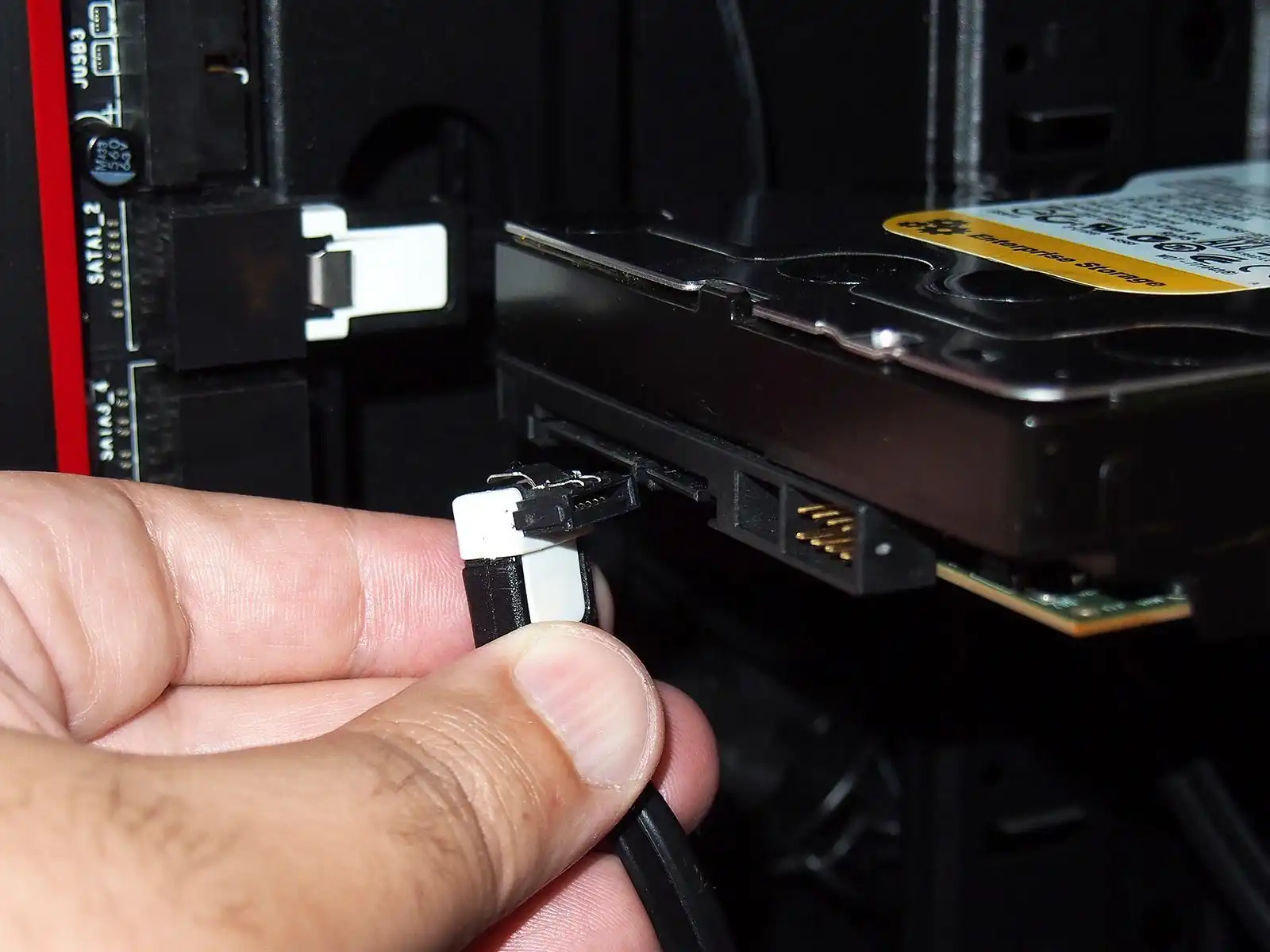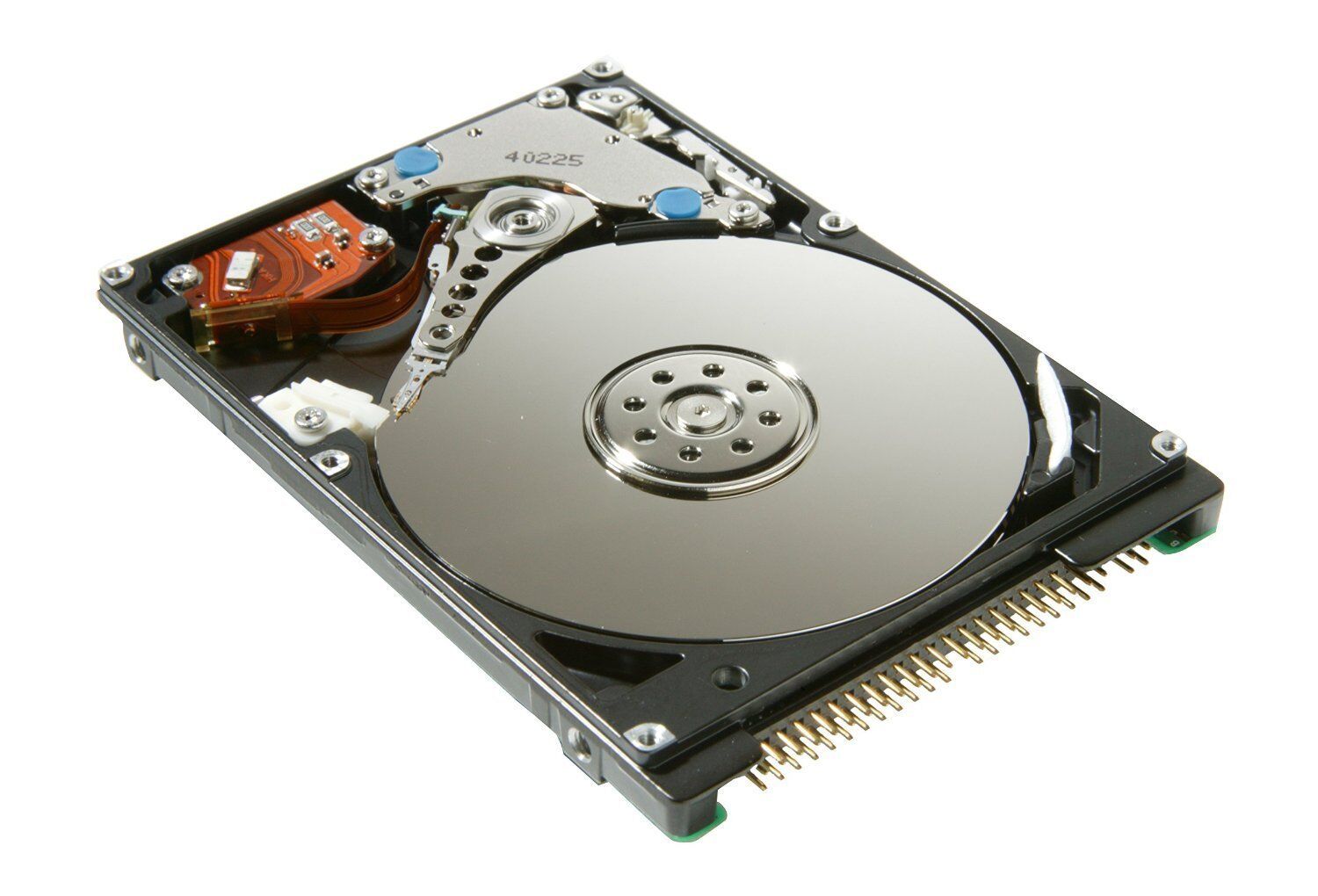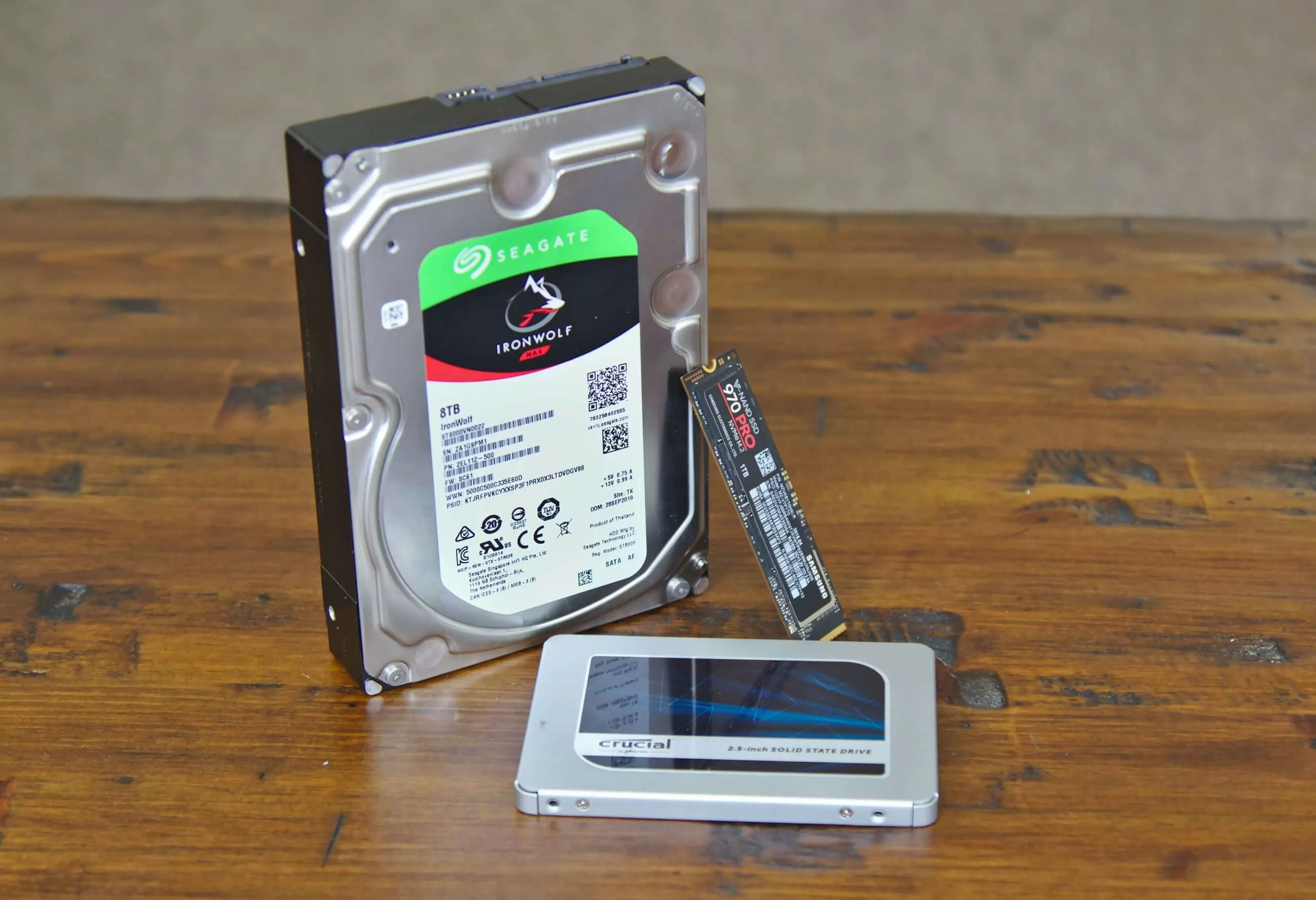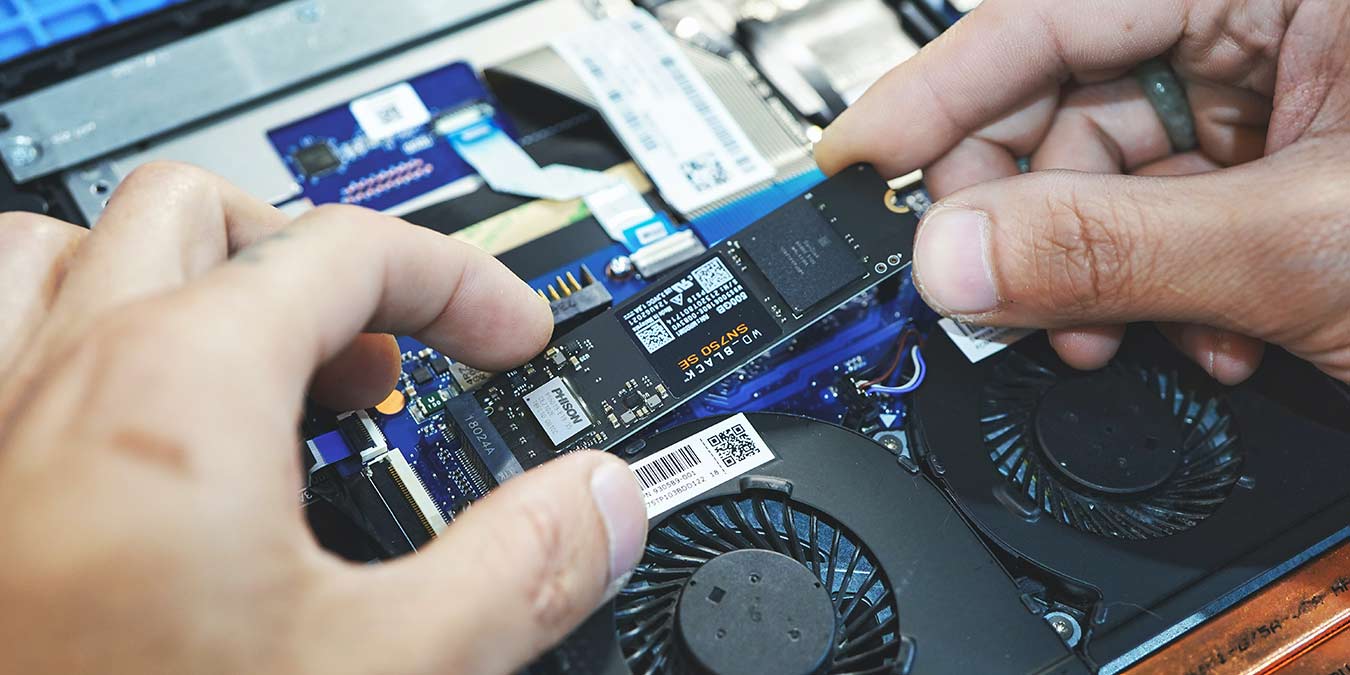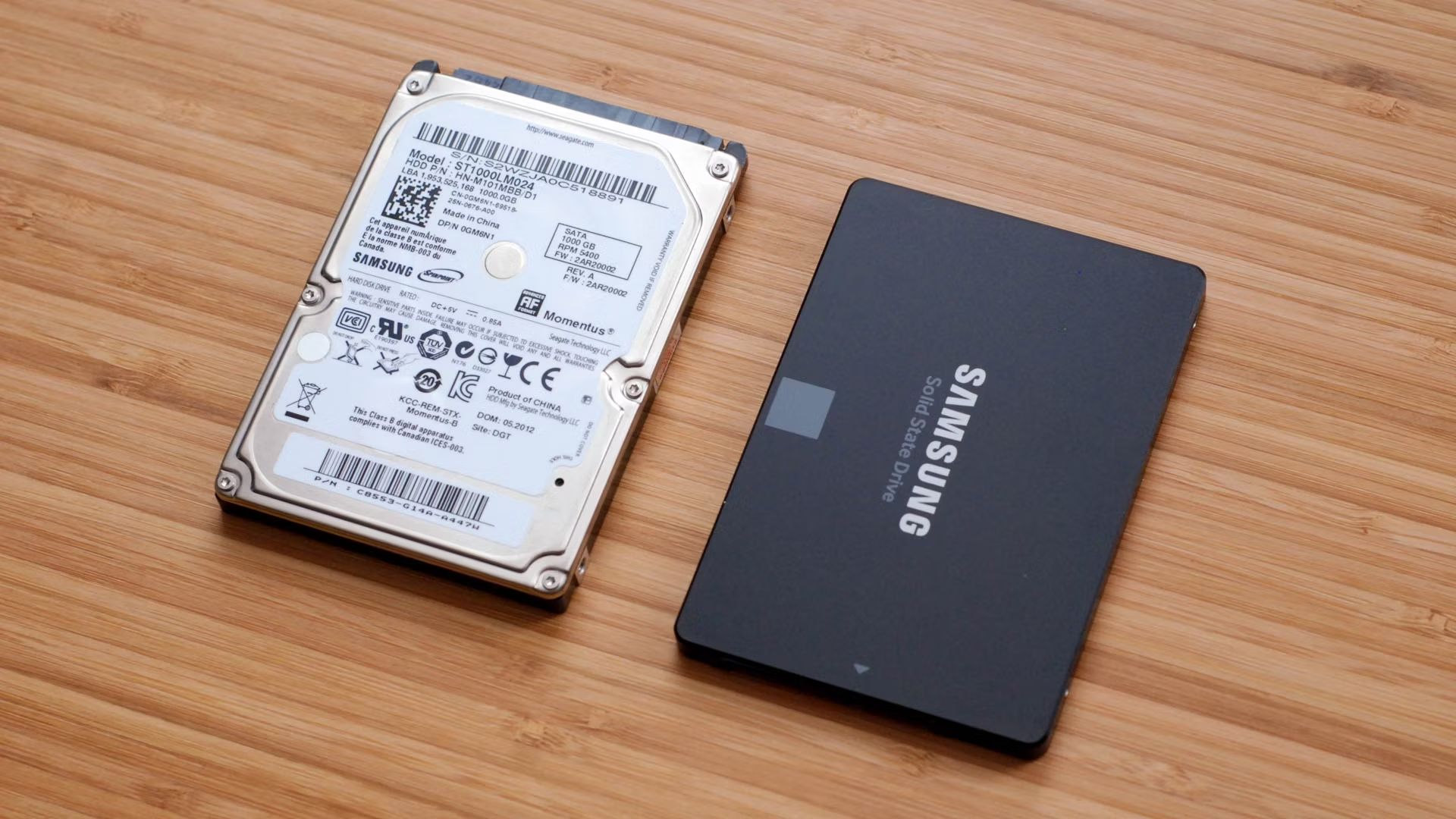Introduction
Welcome to the world of data storage! When it comes to storing and managing your files, two common options you’ll come across are Solid State Drives (SSD) and Hard Disk Drives (HDD). These storage devices have been the backbone of personal computing and are essential in today’s data-driven world.
An SSD and an HDD serve the same primary purpose of storing your data, but they differ in terms of technology, performance, and cost. Understanding the differences between the two and knowing how to best utilize them can greatly enhance your overall computing experience.
In this article, we will delve into the world of SSD and HDD, explore their benefits and differences, and provide you with valuable insights on how to effectively use them together for optimal performance. Whether you’re a tech-savvy individual or a casual user, this guide will help you make informed decisions about your storage needs and ensure that your data is secure and easily accessible.
So, let’s dive right in and explore the wonderful world of SSD and HDD!
What is an SSD?
A Solid State Drive, commonly referred to as an SSD, is a type of storage device that uses flash memory to store data. Unlike traditional Hard Disk Drives (HDD), which rely on spinning disks and mechanical parts, SSDs have no moving parts, making them faster, more durable, and quieter.
The key component of an SSD is the NAND flash memory, which retains data even when the power is turned off. This technology allows for faster read and write speeds, resulting in snappy performance and reduced loading times for various applications and files.
SSDs are generally smaller in size compared to HDDs and come in various form factors, such as 2.5-inch drives for laptops and desktops, M.2 drives for ultra-thin devices, and PCIe expansion card drives for high-performance desktops.
One of the major advantages of SSDs is their speed. The absence of moving parts allows data to be accessed almost instantly, resulting in lightning-fast boot times, rapid file transfers, and seamless multitasking. Whether you’re launching an application, copying files, or browsing the web, an SSD can significantly enhance your overall computing experience.
Moreover, SSDs offer significant improvements in durability and reliability. Since there are no spinning disks or moving parts, they are less prone to mechanical failures and can withstand shocks and vibrations better than HDDs. This makes SSDs a preferred choice for portable devices like laptops, where durability is crucial.
Despite their numerous benefits, SSDs are generally more expensive than HDDs in terms of cost per storage capacity. However, their prices have been steadily decreasing over the years, making them more affordable and accessible to a wider audience.
In the next section, we will explore what exactly a Hard Disk Drive (HDD) is and how it differs from an SSD.
What is an HDD?
A Hard Disk Drive, commonly known as an HDD, is a traditional storage device that has been widely used for decades. It consists of one or more spinning disks, also known as platters, coated with a magnetic material. These platters rotate at high speeds, and data is read from or written to them using mechanical arms with read/write heads.
HDDs are available in various form factors, including 3.5-inch drives for desktop computers and 2.5-inch drives for laptops. They are known for providing large storage capacities at relatively lower costs compared to SSDs.
One of the main advantages of HDDs is their cost-effectiveness. The cost per gigabyte of storage space is significantly lower compared to SSDs, making HDDs a popular choice for storing large amounts of data, such as videos, music, and images.
Although HDDs tend to be slower than SSDs, they still offer respectable performance for everyday computing tasks. The rotational speed of the platters, measured in revolutions per minute (RPM), plays a crucial role in determining the read and write speeds. Higher RPM drives typically offer faster performance, but they may generate more heat and consume more power.
Another advantage of HDDs is their long-standing reliability. With proper care, HDDs can last for several years, making them a reliable option for long-term storage. Additionally, data recovery from HDDs can be easier and less costly compared to SSDs in case of any data loss or hardware failure.
However, HDDs are not without their drawbacks. Because of their mechanical nature, they are more susceptible to physical damage and failure due to shocks, drops, or excessive heat. The spinning platters and mechanical arms can also generate noise and vibrations, making HDDs noisier compared to the silent operation of SSDs.
Despite these limitations, HDDs remain a popular choice for storing large amounts of data, backups, and archive purposes where cost is a significant factor.
In the next section, we will discuss the differences between SSDs and HDDs, enabling you to determine which option best suits your needs.
Differences between SSD and HDD
While both Solid State Drives (SSD) and Hard Disk Drives (HDD) serve the purpose of storing data, they differ significantly in terms of technology, performance, and other factors. Understanding these differences can help you choose the right storage option for your specific needs. Let’s take a closer look at some of the key distinctions between SSDs and HDDs.
1. Technology: The main technological difference between SSDs and HDDs lies in how they store and retrieve data. SSDs use flash memory, a type of non-volatile memory that retains data even when the power is turned off. In contrast, HDDs use spinning disks or platters coated with a magnetic material, along with mechanical arms and read/write heads to read and write data.
2. Speed: SSDs are known for their blazing-fast performance. Since they have no moving parts, data can be accessed almost instantaneously, resulting in quicker boot times, faster file transfers, and rapid application launches. HDDs, on the other hand, are relatively slower due to the mechanical nature of their operation, as the read/write heads need to physically move to access the data on the rotating platters.
3. Durability: SSDs have the upper hand in terms of durability. With no moving parts, they are more resistant to shock, vibration, and physical impact. This makes them ideal for portable devices like laptops, where data integrity and reliability during travel or movement are crucial. HDDs, with their mechanical components, are more susceptible to failure and data loss when subjected to physical stress.
4. Noise and Power Consumption: Since SSDs don’t have any moving parts, they operate silently. HDDs, on the other hand, can generate noise and vibrations when the spinning disks and mechanical arms are in operation. In terms of power consumption, SSDs are more energy-efficient compared to HDDs, leading to improved battery life in laptops and lower electricity bills for desktop systems.
5. Capacity and Cost: HDDs offer higher storage capacities at a lower cost per gigabyte compared to SSDs. This makes them an ideal choice for users who require large storage spaces for multimedia files, bulk data storage, and backup purposes. However, the cost of SSDs has been gradually decreasing, making higher-capacity SSDs more affordable and accessible.
It’s important to consider these differences and weigh them against your specific requirements when deciding between SSDs and HDDs for your storage needs. In the next section, we will explore the benefits of using SSDs and HDDs together.
Benefits of using SSD and HDD together
While Solid State Drives (SSD) and Hard Disk Drives (HDD) have their own unique advantages, using them together in a hybrid setup can offer the best of both worlds. This combination can provide optimal performance, cost-effectiveness, and ample storage capacity. Let’s explore the benefits of using SSDs and HDDs together:
1. Speed and Performance: By installing the operating system and frequently used applications on the SSD, you can harness the lightning-fast speed and responsiveness of the SSD. The faster boot times, rapid application launches, and snappy performance will significantly enhance your overall computing experience. Meanwhile, using the HDD for storing large files, such as videos, photos, or less frequently accessed data, allows you to take advantage of the HDD’s cost-effective storage capacity.
2. Cost-Effectiveness: SSDs are generally more expensive per gigabyte than HDDs. By using them together, you can allocate the costly SSD storage for crucial files and applications while utilizing the cheaper HDD storage for less critical data. This ensures that you get the best performance where it matters the most without breaking the bank.
3. Ample Storage Capacity: HDDs excel in providing large storage capacities at a more affordable price. Combining an SSD with an HDD allows you to have the best of both worlds – fast and efficient storage for frequently accessed files and ample space for storing vast amounts of data. You can store your operating system, applications, and essential files on the SSD for quick access, while using the HDD for storing multimedia files, backups, and archives.
4. Flexibility and Customization: Having both SSD and HDD in your system adds flexibility and customization options. You can decide which files or applications to store on the SSD or HDD, based on their importance and usage frequency. This level of control allows you to optimize your storage setup to suit your specific needs.
5. Redundancy and Data Protection: SSDs tend to be more reliable and less prone to failure than HDDs due to their sturdy construction and lack of moving parts. By utilizing both SSD and HDD, you can create a redundancy system where critical files and backups are stored on different drives. This helps protect your important data from hardware failures or unexpected data loss.
By combining SSDs and HDDs, you can enjoy the benefits of fast performance, ample storage capacity, and cost-effectiveness. In the next section, we will provide a step-by-step guide on how to set up and utilize SSD and HDD together for optimal performance.
How to Use SSD and HDD for Optimal Performance
Now that you understand the benefits of using Solid State Drives (SSD) and Hard Disk Drives (HDD) together, let’s explore how to set up and utilize them for optimal performance. By following these steps, you can maximize the benefits of both types of storage devices:
1. Determine the storage allocation: Decide which files and applications are most important to you and would benefit from the faster speed of the SSD. These can include your operating system, frequently used programs, and files that require quick access. Allocate these to the SSD, while using the HDD for less critical data such as media files, backups, and archives.
2. Install the operating system on the SSD: To ensure fast boot times and overall system responsiveness, install your operating system on the SSD. This will significantly reduce the time it takes for your computer to start up and become accessible.
3. Set up program installation preferences: When installing new applications, specify the SSD as the installation location for those programs that require high performance, such as video editing software, graphic design tools, or games. For applications that don’t require fast access times, choose the HDD as the installation destination.
4. Move frequently accessed files to the SSD: Identify files or folders that you frequently access and would benefit from faster load times. These can include commonly used documents, project files, or your favorite multimedia files. By moving these files to the SSD, you can experience quicker access and improved performance.
5. Utilize the HDD for bulk storage: Take advantage of the HDD’s larger storage capacity by using it for storing large media files, such as videos, photos, and music collections. Backup files, archives, and less frequently accessed data can also be stored on the HDD, ensuring that you have ample space for all your storage needs.
6. Use symbolic links or junctions: Symbolic links or junctions allow you to create shortcuts to folders or files on different drives. This feature can be useful for seamlessly integrating the SSD and HDD storage. For example, you can create a symbolic link on the SSD that points to a folder on the HDD, allowing you to access files on the HDD as if they were stored on the SSD.
7. Regularly clean up and optimize your storage: Over time, both SSD and HDD can accumulate unnecessary files and become fragmented, affecting their performance. Regularly clean up your drives by deleting unused files and run disk optimization utilities to keep your storage devices running smoothly.
By following these steps and utilizing the strengths of both SSD and HDD, you can create a balanced storage setup that ensures optimal performance, efficient file management, and ample storage capacity. In the next section, we will provide a step-by-step guide on how to set up SSD and HDD for your system.
Step-by-Step Guide for Setting Up SSD and HDD
Setting up Solid State Drives (SSD) and Hard Disk Drives (HDD) together requires a few simple steps to ensure the proper configuration and utilization of both storage devices. Follow this step-by-step guide to set up SSD and HDD for optimal performance:
Step 1: Install the SSD: If you’re adding a new SSD to your system, physically install it by connecting the drive to an available SATA port on your motherboard. Make sure to secure it in place with screws or any provided mounting brackets.
Step 2: Connect the HDD: If you already have an HDD in your system, ensure it is properly connected to a separate SATA port on your motherboard. If you’re adding a new HDD, follow the same installation process as the SSD.
Step 3: Boot into BIOS/UEFI: Restart your computer and enter the BIOS (or UEFI) settings by pressing the appropriate key during the boot-up process (common keys include F2, Del, or Esc). Navigate to the storage or boot options and check if both SSD and HDD are detected by the system.
Step 4: Install the operating system: If you’re starting with a fresh installation of the operating system, choose the SSD as the installation destination. Ensure that you select the correct drive during the installation process to avoid overwriting any existing data on the HDD.
Step 5: Format the HDD: If you’re using an existing HDD that is not already formatted, you’ll need to format it to make it accessible for storing files. Right-click on the HDD drive in your operating system’s file explorer, select “Format,” and choose the appropriate file system (such as NTFS for Windows or APFS for macOS).
Step 6: Set up libraries or folders: In your operating system, set up libraries or specific folders on both the SSD and HDD to organize your files. For example, you can create a “Documents” library on the SSD for frequently accessed files and another “Media” library on the HDD for storing multimedia files.
Step 7: Change default installation locations: In the settings of software or applications, configure the default installation location to the appropriate drive. For essential applications that require fast access, set the installation destination to the SSD. For other applications or games that don’t require quick load times, select the HDD as the installation location.
Step 8: Move files and create symbolic links: Transfer files from the HDD to the SSD that you want to have faster access to. For larger files or less frequently accessed data, keep them on the HDD. To maintain a seamless file structure, create symbolic links or junctions on the SSD that point to files or folders on the HDD.
Step 9: Regularly manage and optimize storage: As you add or delete files over time, periodically clean up unnecessary files from both the SSD and HDD to free up space. Additionally, run disk optimization utilities to defragment the HDD and maintain its performance.
By following this step-by-step guide, you can properly set up and utilize both SSD and HDD in your system, ensuring optimal performance, efficient file organization, and seamless storage management.
Tips for Managing Storage on SSD and HDD
Properly managing storage on Solid State Drives (SSD) and Hard Disk Drives (HDD) is essential for maintaining optimal performance, maximizing available space, and extending the lifespan of your storage devices. Here are some helpful tips to effectively manage storage on SSD and HDD:
1. Regularly clean up unnecessary files: Periodically go through your files and delete any unnecessary or duplicates. This will help free up valuable space on both the SSD and HDD, allowing you to efficiently utilize the available storage capacity.
2. Utilize storage optimization tools: Take advantage of built-in storage optimization tools provided by your operating system. These tools, such as Disk Cleanup (Windows) or Optimized Storage (macOS), can help identify and remove system junk files, temporary files, and other unnecessary data.
3. Move large files to the HDD: Transfer large files, such as videos, media libraries, and archives, from the SSD to the HDD. This will free up space on the SSD for files that require faster access, while utilizing the larger storage capacity of the HDD for less frequently accessed data.
4. Offload less-used applications to the HDD: If you have applications that you seldom use but want to keep installed, consider moving them to the HDD. This will help optimize space on the SSD, ensuring that it is reserved for applications that require faster performance.
5. Utilize cloud storage or external drives: Take advantage of cloud storage services or external drives to store files that you don’t need immediate access to. This can help free up significant space on both the SSD and HDD, as these files are safely stored off-site.
6. Maintain proper backups: Regularly back up your important files on external drives or cloud storage. This ensures that your data is protected in case of any hardware failure or data loss on either the SSD or HDD.
7. Monitor storage usage: Keep an eye on your storage usage to identify any inefficiencies or unnecessary files taking up valuable space. Many operating systems provide built-in tools to monitor disk space usage, allowing you to take appropriate actions to manage your storage effectively.
8. Update your operating system and drivers: Keeping your operating system and device drivers up to date can help optimize storage performance and address any potential issues or bugs that may affect SSD or HDD functionality.
9. Be mindful of write cycles on SSD: While SSDs have improved in terms of longevity, it’s still important to be mindful of unnecessary write operations. Avoid excessive file transfers or constantly re-writing large files on the SSD, as this can reduce its lifespan over time.
10. Regularly defragment the HDD: If you’re using an HDD, running periodic defragmentation can improve its performance by optimizing the arrangement of files on the disk. Most operating systems provide built-in disk defragmentation tools for this purpose.
By implementing these tips, you can effectively manage storage on both SSD and HDD, ensuring optimized performance, efficient usage of space, and a seamless storage experience.
Frequently Asked Questions about using SSD and HDD
Here are answers to some commonly asked questions regarding the usage of Solid State Drives (SSD) and Hard Disk Drives (HDD):
1. Can I use an SSD and HDD together in the same system?
Yes, utilizing both an SSD and HDD together is a common practice in many systems. This allows you to take advantage of the speed and performance of the SSD for critical applications and frequently accessed files, while leveraging the larger storage capacity of the HDD for mass storage and less frequently accessed data.
2. Can I install the operating system on both the SSD and HDD?
Yes, you can install the operating system on either the SSD or HDD. However, it is recommended to install the operating system on the SSD for faster boot times and overall system responsiveness. Installing the OS on the SSD ensures that you benefit from the SSD’s speed, while leaving the HDD for additional storage space.
3. Can I move files between the SSD and HDD without reinstalling programs?
Yes, you can easily move files between the SSD and HDD without reinstalling the programs. For example, you can move media files or documents from the SSD to the HDD by simply copying or cutting and pasting them. However, it is important to note that some programs may require adjustment in their settings to locate the files in their new location.
4. How do SSDs and HDDs differ in terms of lifespan?
SSDs and HDDs have different lifespan characteristics. SSDs have a limited number of write cycles before they may start to degrade, although modern SSDs have improved significantly in this aspect. On the other hand, HDDs are generally more robust in terms of lifespan due to their mechanical nature. With proper care, both SSDs and HDDs can last for many years.
5. Should I defragment an SSD?
No, it is not necessary to defragment an SSD. Unlike HDDs, which can benefit from defragmentation to optimize file arrangement on the disk, SSDs work differently. They have no mechanical seek time, so defragmentation doesn’t affect their performance. In fact, unnecessary defragmentation on an SSD may even reduce its lifespan due to unnecessary write operations.
6. Can I replace my HDD with an SSD?
Yes, it is possible to replace your existing HDD with an SSD. However, consider the storage capacity and cost per gigabyte of an SSD when making the decision. If you have a large amount of data that exceeds the capacity of an affordable SSD, you may choose to keep the HDD for additional storage and use the SSD as the primary drive for faster performance.
7. Can I use an external SSD or HDD for backup purposes?
Yes, external SSDs and HDDs are commonly used for backup purposes. You can connect an external storage device to your computer and use backup software or manually copy your important files to the drive. This provides an additional layer of data protection in case of system failures or data loss.
Remember that the specific compatibility and setup of SSDs and HDDs may vary depending on the system and operating system you are using. It’s always recommended to refer to the manufacturer’s documentation and software guides for optimal usage and compatibility information.
Conclusion
Understanding the differences and benefits of Solid State Drives (SSD) and Hard Disk Drives (HDD) is crucial in making informed decisions about your storage needs. While SSDs offer lightning-fast performance and durability, HDDs provide larger storage capacities at a more affordable cost. By utilizing both SSD and HDD together, you can enjoy the advantages of speed, ample storage, and cost-effectiveness.
Setting up SSD and HDD requires careful consideration of allocating storage, installing the operating system, and managing files. By following the step-by-step guide, you can achieve optimal performance and efficient storage utilization. Remember to prioritize frequently used applications and files on the SSD while utilizing the HDD for less critical data and backup purposes.
Effective storage management on SSD and HDD involves regular clean-ups, utilizing storage optimization tools, and being mindful of write operations on the SSD. By implementing these tips, you can ensure efficient usage of space, prolong the lifespan of your storage devices, and maintain optimal performance.
Lastly, it’s important to note that the specific requirements and compatibility of SSDs and HDDs may vary depending on your system and operating system. Stay informed by referring to the manufacturer’s documentation and software guidelines for optimal usage and compatibility information.
With the right setup and storage management, combining the speed and performance of SSDs with the larger storage capacities of HDDs can provide a well-rounded storage solution for all your needs. So, embrace the power of SSD and HDD, and enjoy a seamless and efficient computing experience!







